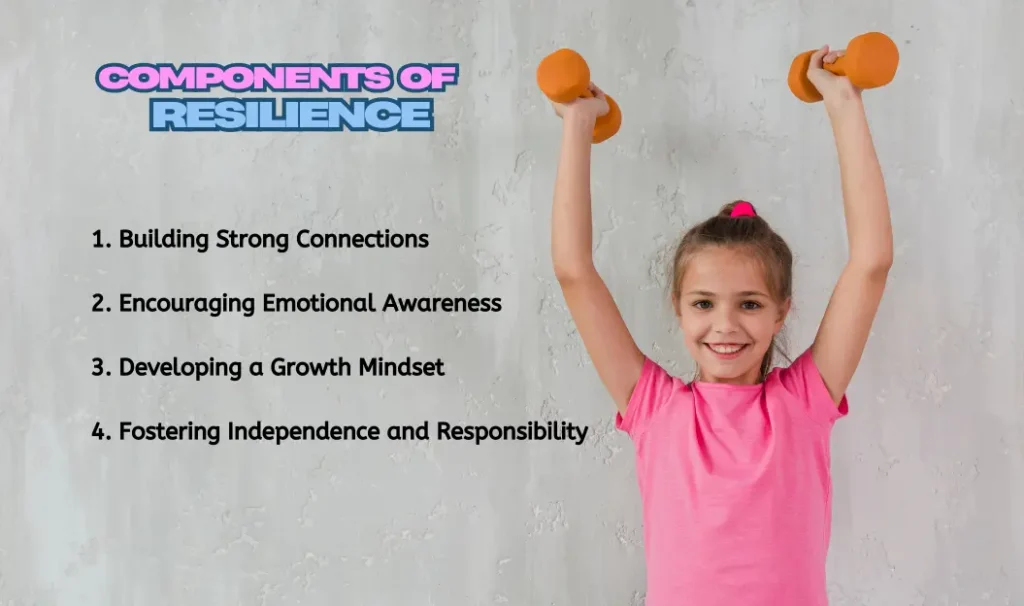Raising resilient kids doesn’t have to be a mystery. Resilience is all about teaching your child to bounce back from challenges, adapt to changes, and grow stronger from adversity. Curious to learn how? Keep reading to discover actionable tips and strategies that will transform how you nurture resilience in your child.
Understanding Resilience in Children
What is Resilience?
Resilience is a child’s ability to recover from difficulties and grow stronger in the process. Think of it as their emotional immune system—it helps them handle setbacks, failures, and stress without losing their sense of self-worth.
“Resilience isn’t a trait; it’s a skill that can be nurtured.” — Dr. Ann Masten, child psychologist.
Why is Resilience Important?
Children who develop resilience are better equipped to handle life’s challenges, whether it’s overcoming a tough test at school, dealing with peer pressure, or bouncing back from a failed project. Studies show that resilient children tend to:
- Have better mental health and emotional regulation.
- Excel in problem-solving and decision-making.
- Build stronger relationships with peers and adults.
According to Harvard Graduate School of Education, resilience is developed through supportive relationships, adaptive capacities, and positive experiences. This highlights the importance of fostering strong connections and creating a nurturing environment to help children thrive.
Case Study: Sarah, an 8-year-old, struggled with anxiety after losing a school competition. Her parents used storytelling to teach her about famous figures who overcame failures, such as Thomas Edison. Over time, Sarah’s perspective shifted, and she started viewing challenges as learning opportunities.
The Role of Parents and Caregivers
Parents are the cornerstone of resilience-building. By modeling problem-solving behaviors and fostering a secure, supportive environment, you create the perfect conditions for your child to thrive. Here’s how you can start:
- Be a role model: Show them how you handle stress.
- Create a safe space: Encourage open communication without judgment.
- Praise efforts, not outcomes: Focus on what they learned rather than whether they succeeded.
Key Components of Resilience

1. Building Strong Connections
Relationships are the foundation of resilience. When children feel supported by family, friends, and trusted adults, they’re more likely to navigate challenges successfully.
Tips for Parents:
- Spend quality one-on-one time with your child daily.
- Encourage teamwork through group activities or family projects.
- Teach empathy by helping them understand and respect others’ feelings.
2. Encouraging Emotional Awareness
Understanding and managing emotions is a critical skill for resilience. Helping children identify their feelings and express them constructively is essential.
Practical Steps:
- Use “feelings charts” to help younger kids label emotions.
- Practice deep breathing exercises to manage overwhelming emotions.
- Model emotional regulation by staying calm during stressful situations.
3. Developing a Growth Mindset
A growth mindset, the belief that abilities can improve with effort, enables children to see challenges as opportunities rather than obstacles.
How to Foster It:
- Celebrate efforts over achievements (e.g., “You worked so hard on this project!”).
- Share stories of resilience, such as athletes who overcame setbacks.
- Avoid labeling mistakes as failures; instead, treat them as valuable lessons.
4. Fostering Independence and Responsibility
Allowing children to take age-appropriate risks and responsibilities builds confidence and decision-making skills.
Actions to Take:
- Give them simple tasks like planning a family outing or managing their weekly allowance.
- Let them solve minor problems independently while offering guidance when needed.
- Praise their initiative and resourcefulness.
Practical Strategies for Parents
Model Resilient Behaviors
Children learn best by example. By demonstrating how you handle stress, setbacks, and unexpected changes, you provide a blueprint for resilience.
Tips:
- Stay calm and composed during challenging moments.
- Use positive self-talk and share it openly with your child (e.g., “I’m feeling frustrated, but I know I can figure this out”).
- Reflect on your own mistakes and discuss what you’ve learned from them.
Create a Safe and Supportive Environment
Resilience thrives in a secure and nurturing atmosphere. A child who feels loved and supported is better prepared to handle life’s hurdles.
Suggestions:
- Establish consistent family routines to give children a sense of stability.
- Encourage open communication by listening without judgment.
- Reassure them that they can always come to you for help and guidance.
Teach Problem-Solving Skills
Resilient children view challenges as opportunities to learn and grow. Helping them develop problem-solving skills lays a strong foundation for lifelong adaptability.
Steps:
- Break down problems into smaller, manageable parts.
- Encourage them to brainstorm multiple solutions.
- Guide them through the process of evaluating options and choosing the best course of action.
Promote Healthy Risk-Taking
Taking risks helps children learn to cope with uncertainty and build confidence in their abilities. By allowing them to step out of their comfort zones, you encourage growth.
Ways to Encourage Healthy Risk-Taking:
- Introduce new activities, such as joining a sports team or trying out for a school play.
- Praise their courage to attempt something unfamiliar, regardless of the outcome.
- Help them reflect on what they learned from the experience, even if it didn’t go as planned.
Activities to Build Resilience
Mindfulness and Relaxation Exercises Helping children manage stress through relaxation techniques can build their inner strength.
Suggestions:
- Practice deep breathing exercises together (e.g., counting to four on an inhale, holding for four counts, and exhaling for four counts).
- Encourage simple meditation sessions where children focus on their breathing or visualize a calming place.
- Introduce yoga poses tailored for kids to improve focus and reduce anxiety.
Storytelling and Role-Playing Stories can be powerful tools to teach children about resilience.
Examples:
- Read books about characters who overcome challenges, then discuss the lessons learned.
- Encourage children to create their own stories where they solve problems or face their fears.
- Use role-playing scenarios to practice handling peer conflicts or trying new experiences.
Creative Arts and Expression Creative activities provide children with outlets for processing emotions and building confidence.
Activities:
- Have them draw or paint how they feel during challenging times.
- Encourage writing in a journal or creating a comic strip about a resilient superhero.
- Experiment with music or dance as a way to release stress and find joy.
Outdoor Adventures and Team Activities Physical activity and teamwork naturally foster resilience.
Ideas:
- Organize family hikes or nature walks that include small challenges, like climbing a hill or navigating a trail.
- Involve them in team sports to teach cooperation, communication, and dealing with setbacks.
- Plan obstacle courses or treasure hunts that require creative thinking and persistence.
Overcoming Common Challenges
Dealing with Failure and Setbacks Helping children understand that failure is part of the learning process is essential. Instead of fearing mistakes, they can see them as opportunities to grow.
Tips:
- Share personal experiences of times you failed and how you bounced back.
- Reframe failure as a stepping stone toward success.
- Encourage them to set small, achievable goals after a setback.
Handling Peer Pressure and Bullying Navigating social challenges like peer pressure and bullying can be tough, but teaching children how to respond effectively can strengthen their resilience.
Practical Advice:
- Role-play scenarios where they practice standing up for themselves.
- Teach them to seek out supportive friends and trusted adults.
- Discuss ways to stay calm and assertive in difficult situations.
Balancing Academics and Extracurriculars Children often feel overwhelmed when they have too much on their plate. Learning to balance their commitments can help them maintain emotional well-being.
Suggestions:
- Teach them time-management skills, such as using a calendar or planner.
- Encourage them to prioritize tasks and break large projects into smaller steps.
- Remind them that it’s okay to say “no” sometimes and to make time for rest.
Resources for Parents
Building resilience in your child is a journey, and having access to the right resources can make all the difference. Here are some tools and support systems to guide you along the way.
Books and Literature
Explore insightful books that offer practical strategies for fostering resilience.
- The Whole-Brain Child by Daniel J. Siegel and Tina Payne Bryson
- Raising Resilient Children by Robert Brooks and Sam Goldstein
- Grit: The Power of Passion and Perseverance by Angela Duckworth
Reading these books provides valuable perspectives on nurturing resilience.
Online Communities and Support Groups
Connect with other parents to share experiences and advice.
- Parenting forums: Platforms like Parenting Stack Exchange or What to Expect Community
- Social media groups: Join Facebook groups focused on child development and resilience-building.
- Local support networks: Check for parenting workshops or support groups in your community.
These spaces offer reassurance and a sense of camaraderie.
Professional Help
Sometimes, resilience-building requires expert guidance.
- Counseling and therapy: Consult a child therapist if your child struggles significantly with stress or setbacks.
- School resources: Many schools have counselors or support staff who can help.
- Choosing a professional: Look for licensed therapists with experience in child psychology or developmental resilience.
Professional help ensures your child gets the personalized support they need.
Conclusion
Raising a resilient child takes patience, consistency, and the right tools. By understanding resilience, fostering its key components, and using practical strategies, you’re giving your child the strength to face life’s challenges with confidence. Remember, resilience is a skill they’ll carry for a lifetime, and your support makes all the difference.
FAQ: Raising Resilient Kids
1. What is resilience in children?
Resilience is a child’s ability to bounce back from challenges and grow stronger in the process. It helps them cope with setbacks and stress without losing their self-worth.
2. Why is resilience important?
Resilient children are better at managing stress, solving problems, and forming strong relationships. They tend to have better mental health and emotional regulation.
3. How can parents help build resilience in their children?
Parents can model resilient behaviors, create a safe and supportive environment, praise efforts, and teach problem-solving skills. Encouraging emotional awareness and fostering independence also helps.
4. What are the key components of resilience?
The key components are building strong connections, emotional awareness, a growth mindset, and fostering independence and responsibility.
5. How can I model resilience for my child?
Stay calm in stressful situations, use positive self-talk, and reflect on your mistakes to show your child how to handle challenges.
6. What activities can build resilience in children?
Mindfulness exercises, storytelling, creative arts, outdoor adventures, and team activities all promote resilience by helping children manage stress and overcome challenges.
7. How can I help my child deal with failure?
Reframe failure as a learning opportunity, share personal experiences, and encourage them to set small, achievable goals after setbacks.
8. How can I teach my child to handle peer pressure?
Role-play scenarios, teach assertiveness, and emphasize the importance of seeking supportive friends and trusted adults.
9. What are some resources to support resilience-building?
Books like The Whole-Brain Child and Grit, online parenting communities, and professional help from counselors or therapists can guide you in fostering resilience.
10. How can I balance my child’s academics and extracurricular activities?
Teach time-management skills, encourage task prioritization, and remind them it’s okay to say “no” to avoid overwhelm.


